Matcha
Optimal Matcha Powder Serving – Get Your Perfect Dose
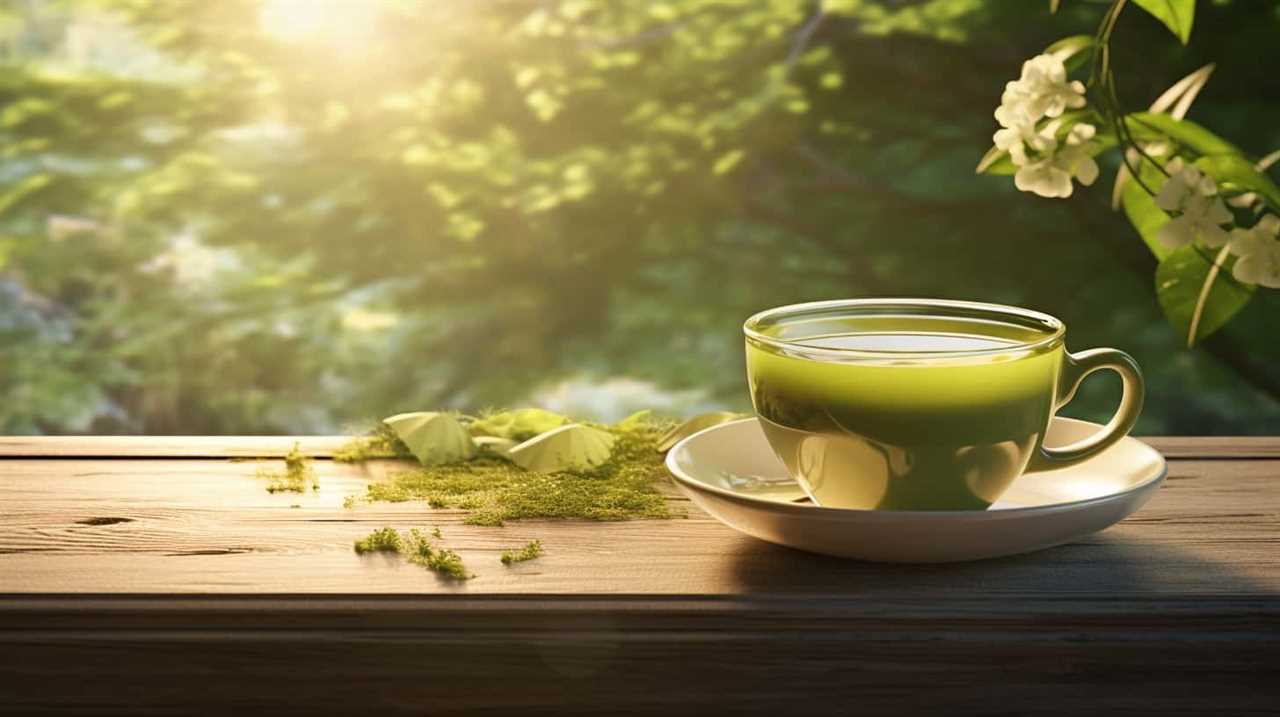
Welcome, fellow matcha enthusiasts!
Have you ever found yourself pondering the eternal question of how much matcha powder to use? Fear not, for we are here to guide you through the realms of matcha measurement mastery.
In this humble introduction, we will unravel the mysteries surrounding the perfect matcha powder amount for various delightful creations. From matcha smoothies to matcha baked goods and even matcha ice cream, we shall uncover the secrets to achieve that impeccable matcha flavor.
So, grab your measuring spoons and prepare to embark on a journey to the land of matcha perfection. Together, we shall learn the art of precise matcha powder measurement, and serve ourselves and others with the ultimate matcha experience.
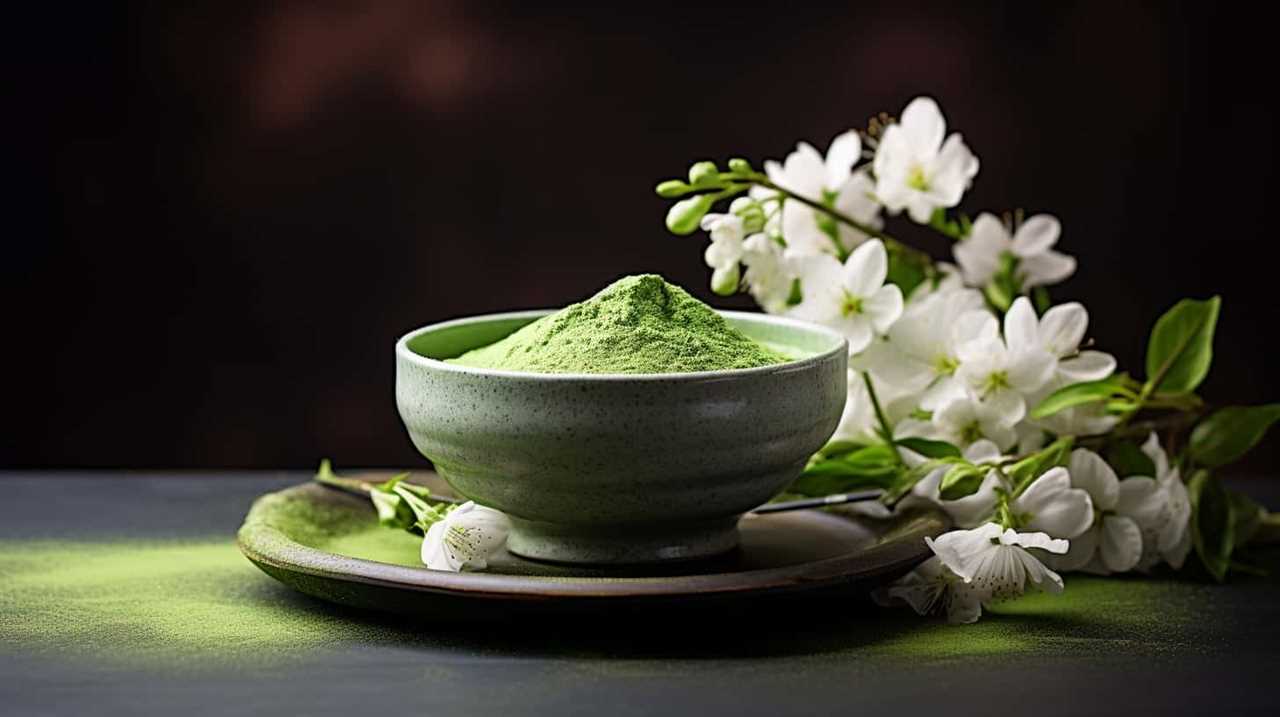
Let us begin!
Key Takeaways
- Matcha powder comes in different grades, with ceremonial grade being the highest quality and culinary grade being more suitable for cooking and baking.
- Matcha is packed with antioxidants, vitamins, and minerals.
- Adjust the matcha serving based on personal preference and the specific recipe being used.
- Generally, use about 1 to 2 teaspoons of matcha powder per 8 ounces of water.
Matcha Powder: A Beginner’s Guide
In our beginner’s guide to matcha powder, we’ll explore how much matcha powder should be used for various recipes and beverages.
Understanding matcha grades and the health benefits of matcha is essential when determining the appropriate amount to use.
Matcha powder comes in different grades, with ceremonial grade being the highest quality and culinary grade being more suitable for cooking and baking. The quality of matcha affects the flavor and intensity, so it’s important to choose the right grade for your needs.
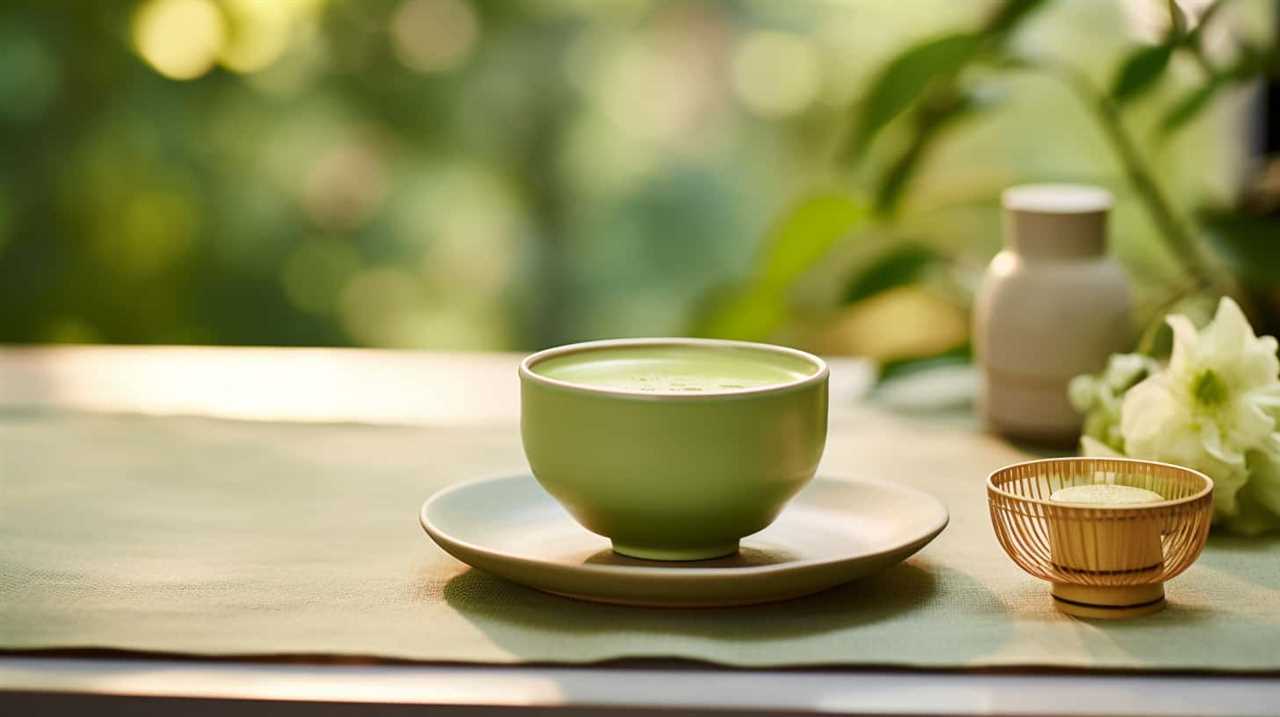
When it comes to health benefits, matcha is packed with antioxidants, vitamins, and minerals. It boosts metabolism, enhances focus, and provides a natural energy boost without the jitters. Incorporating matcha into your diet can also support weight loss, improve heart health, and strengthen the immune system.
Now that we understand the different grades and the health benefits of matcha, let’s talk about how much matcha powder to use in different recipes and beverages. Understanding matcha serving sizes will ensure that you achieve the desired flavor and experience the full benefits of this vibrant green tea.
Understanding Matcha Serving Sizes
Now let’s talk about the points we need to understand when it comes to matcha serving sizes.
One important factor is finding the optimal matcha portion for your taste and desired strength.

It’s also crucial to know how to adjust the matcha serving based on your preferences and the specific recipe you’re using.
Optimal Matcha Portion
How much matcha powder should we use to achieve the optimal serving size and fully understand the portion of matcha? When it comes to adjusting matcha portion sizes, it’s important to measure matcha accurately. Here are five key points to consider:
- Start with the recommended serving size: Generally, a teaspoon (or 2 grams) of matcha powder is a good starting point.
- Adjust based on personal preference: If you prefer a stronger or milder taste, you can increase or decrease the amount of matcha accordingly.
- Consider the desired strength: If you want a more intense flavor, you can add a bit more matcha. For a lighter taste, use a smaller portion.
- Experiment and find your ideal portion: Everyone has different taste preferences, so feel free to experiment with different amounts until you find the perfect balance for you.
- Be mindful of the quality: High-quality matcha may require less powder to achieve the desired flavor, while lower-quality matcha may need a bit more.
Adjusting Matcha Serving
To understand matcha serving sizes, we can adjust the amount of matcha powder we use. Adjusting matcha concentration allows us to customize the strength and flavor of our matcha beverages. By experimenting with matcha ratios, we can find the perfect balance that suits our personal preferences.
If we prefer a stronger taste, we can increase the amount of matcha powder for a more concentrated flavor. Conversely, if we prefer a milder taste, we can decrease the amount of matcha powder.
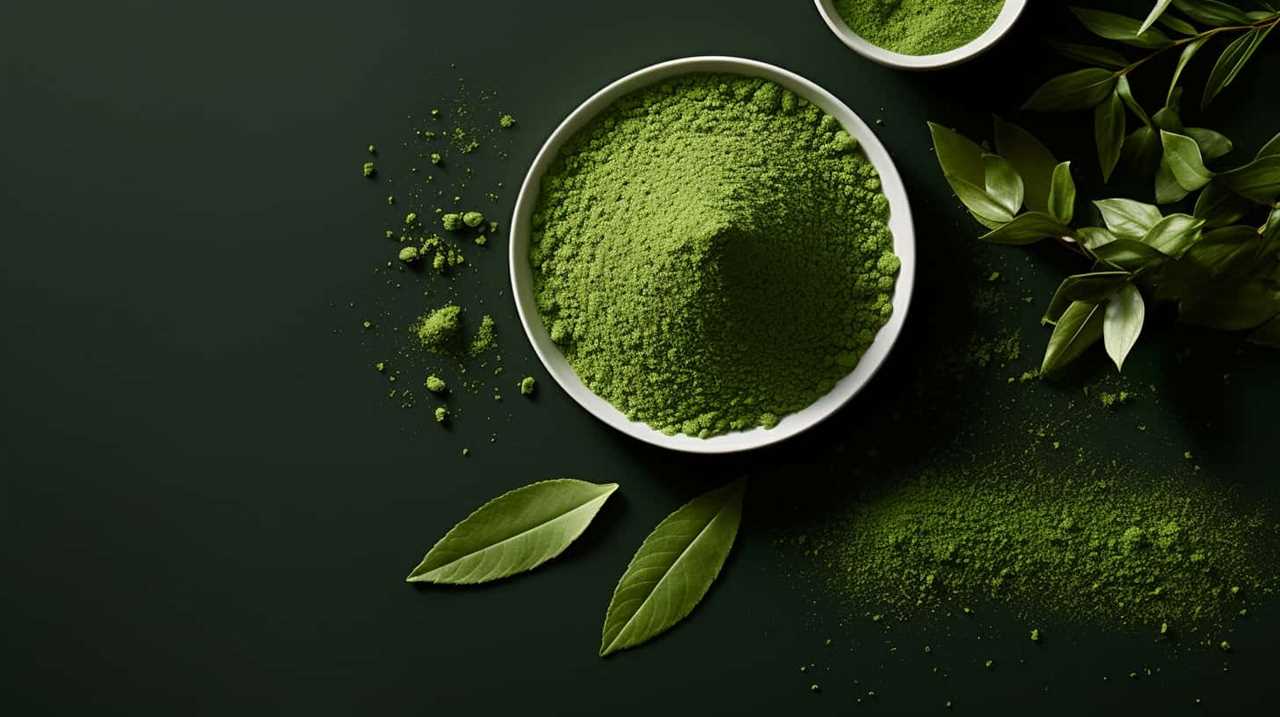
It’s important to note that adjusting matcha serving sizes may require some trial and error. However, by gradually making changes and tasting along the way, we can discover our ideal matcha serving that satisfies our taste buds.
Recommended Matcha Powder Measurements
When it comes to preparing matcha, getting the right amount of powder is crucial. The optimal matcha serving depends on personal preference and the desired intensity of flavor.
However, it’s generally recommended to use about 1 to 2 teaspoons of matcha powder per 8 ounces of water. Accurately measuring the matcha powder ensures a consistent taste and allows for adjustments based on individual taste preferences.
Optimal Matcha Serving
We typically use 1 teaspoon of matcha powder in our recommended serving. This is the optimal matcha portion that provides a balanced and flavorful cup of matcha.

However, it’s important to note that everyone’s taste preferences and desired strength of matcha can vary. Therefore, adjusting the matcha serving to suit individual preferences is always an option.
Here are some factors to consider when adjusting matcha serving:
- Taste preference: If you prefer a stronger matcha flavor, you can add a little more matcha powder.
- Size of the bowl: If you have a larger bowl, you may need to increase the amount of matcha powder to maintain the desired taste.
- Quality of matcha: Higher quality matcha powder tends to have a more intense flavor, so you might need less powder to achieve the desired taste.
- Experience level: If you’re new to matcha, it’s recommended to start with the recommended serving and gradually adjust to your liking.
- Personal preference: Ultimately, the optimal matcha serving is the one that satisfies your taste buds. Experiment and find the perfect amount for you.
Now let’s move on to the next section and talk about measuring matcha accurately.
Measuring Matcha Accurately
For accurate measurement of matcha powder, we recommend using a reliable and precise measuring spoon. This ensures that you can easily adjust the amount of matcha powder for different recipes, particularly when it comes to making matcha desserts.

When measuring matcha for matcha desserts, it’s important to follow the recipe instructions carefully to achieve the desired flavor and consistency. The amount of matcha powder needed may vary depending on the specific recipe and personal preference.
Using a measuring spoon will help you accurately portion the matcha powder and avoid adding too much or too little. This way, you can confidently create delicious matcha desserts that will impress your guests and satisfy their cravings.
Adjusting Matcha Powder Amount
To accurately adjust the amount of matcha powder, it’s essential to rely on recommended measurements. Adjusting matcha powder for different recipes can be a bit tricky, but with the right matcha powder measurement, you can achieve the perfect balance of flavor and intensity.
Here are some tips to help you find the right matcha powder measurement:
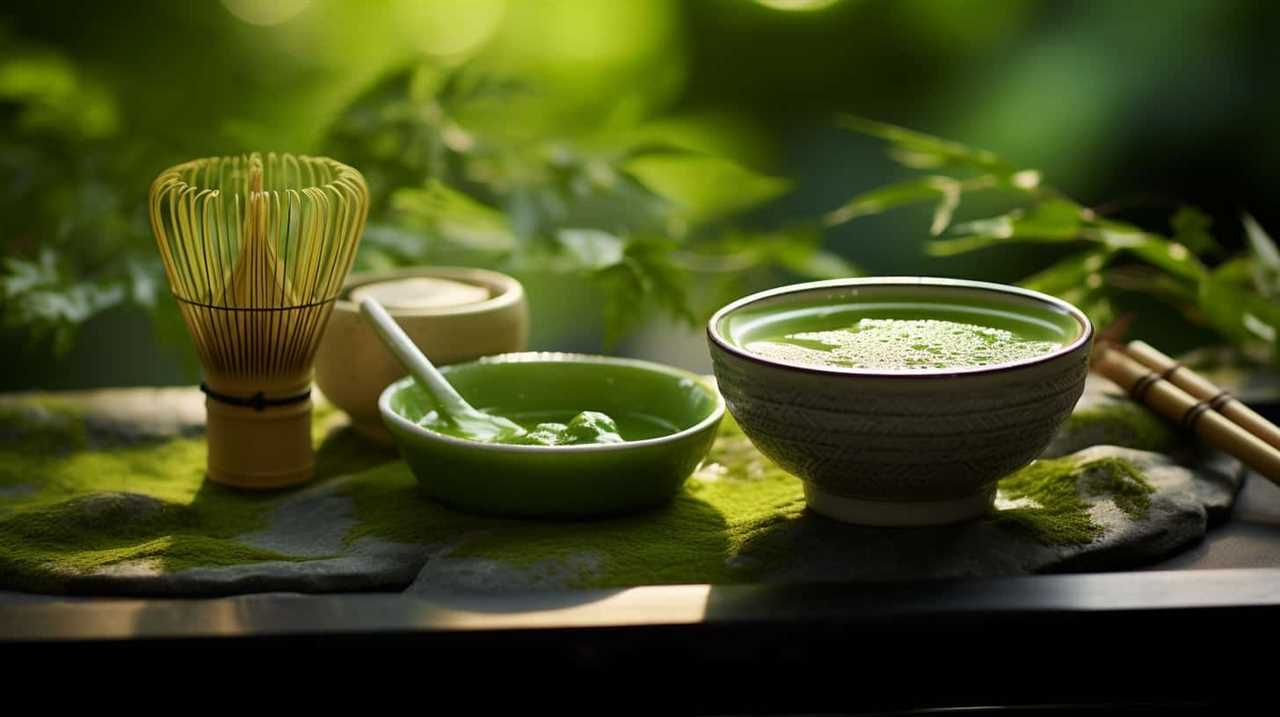
- Start with the recommended amount: Follow the instructions provided in the recipe or on the matcha powder packaging.
- Taste test: Adjust the amount of matcha powder based on your personal preference. Add more for a stronger flavor or less for a milder taste.
- Consider the other ingredients: If the recipe includes other strong flavors, such as chocolate or spices, you may need to adjust the matcha powder measurement accordingly.
- Experiment: Don’t be afraid to experiment with different amounts of matcha powder to find your perfect match.
- Seek guidance: If you’re unsure, consult a trusted recipe or an experienced matcha enthusiast for guidance.
Factors to Consider When Measuring Matcha Powder
What factors should be considered when measuring matcha powder? When it comes to measuring matcha powder, there are a few important factors to keep in mind. These factors include the quality of the matcha powder, the desired strength of the flavor, and the intended use of the matcha powder.
To ensure that you are using the best matcha powder, consider factors such as the origin of the powder, the grade of the powder, and any additional ingredients or additives. Additionally, it is important to properly store matcha powder to maintain its freshness and flavor. Matcha powder should be stored in an airtight container in a cool, dark place to avoid exposure to light, heat, and humidity.
To help you better understand the factors to consider when measuring matcha powder, here is a table summarizing the key points:
| Factors to Consider | Examples |
|---|---|
| Quality of Matcha | Origin, grade, ingredients |
| Desired Flavor | Strength of flavor preference |
| Intended Use | Drinking, baking, cooking |
Considering these factors will help you determine the appropriate amount of matcha powder to use for your specific needs. In the next section, we will discuss how to adjust matcha powder amounts to suit personal preferences.
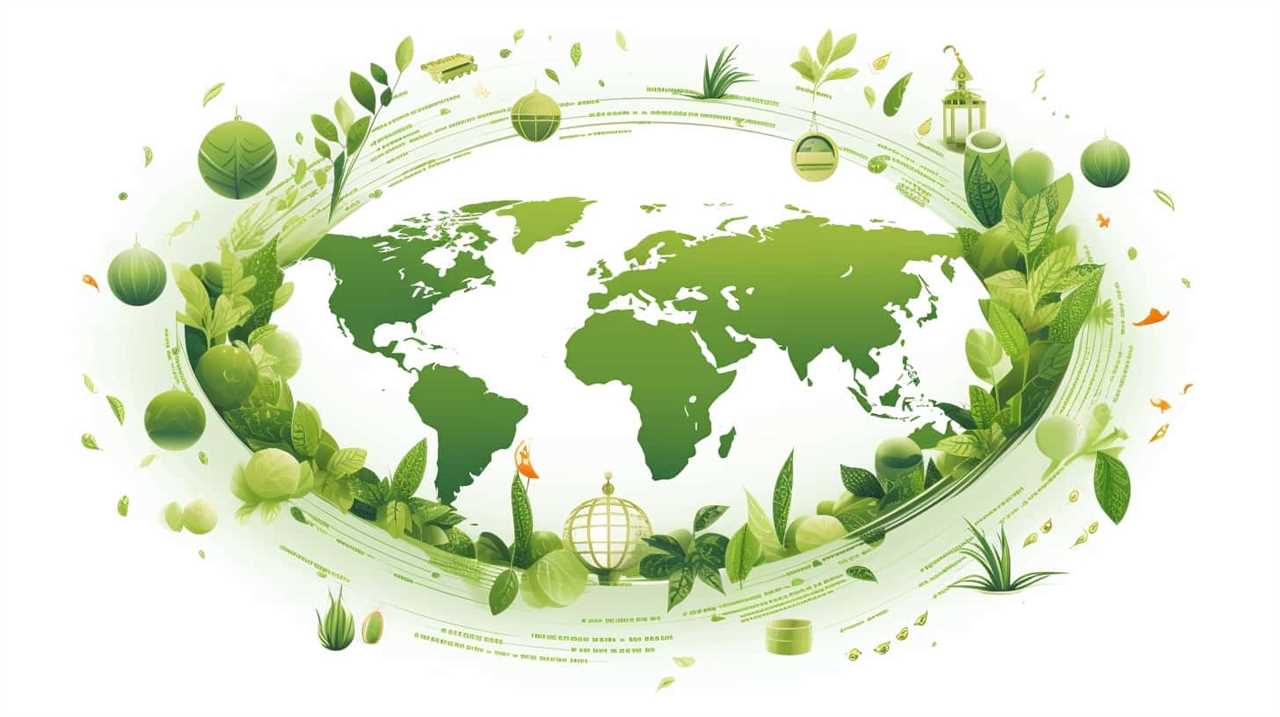
Adjusting Matcha Powder Amounts for Personal Preference
Let’s explore how we can customize the amount of matcha powder to suit our personal taste preferences. Adjusting matcha powder amounts for different recipes allows us to experiment and find the perfect balance of flavor and intensity. Here are five tips to help you in your journey of finding the right matcha powder amount:
- Start with the recommended amount: Most recipes will provide a suggested quantity of matcha powder to use. Begin with this amount and adjust as needed based on your taste preferences.
- Gradually increase or decrease: If you find the matcha flavor too weak, add a little more powder. Conversely, if it’s too strong, reduce the amount. Make small adjustments at a time to avoid overpowering the other ingredients.
- Consider the recipe: Different recipes may require different amounts of matcha powder. For example, a frothy matcha latte might call for more powder than a delicate matcha-infused dessert. Take into account the overall balance of flavors in the recipe.
- Personal taste preference: Some individuals prefer a more intense matcha flavor, while others enjoy a milder taste. Experiment with different amounts of matcha powder to find the perfect balance that suits your palate.
- Keep a record: As you experiment with matcha powder amounts, keep a record of your findings. Note the quantities you used and the resulting taste. This will help you remember your preferences for future recipes.
By adjusting matcha powder amounts for different recipes and experimenting with various quantities, you can create a matcha-infused treat that perfectly suits your personal taste preferences.
Enjoy the process and savor every sip or bite of your homemade matcha creation.
The Importance of Quality Matcha Powder
Quality matcha powder is essential for achieving the best flavor and health benefits in our matcha-infused creations. When it comes to matcha, not all powders are created equal. The quality of matcha can vary depending on factors such as where it’s grown, how it’s processed, and how fresh it is.
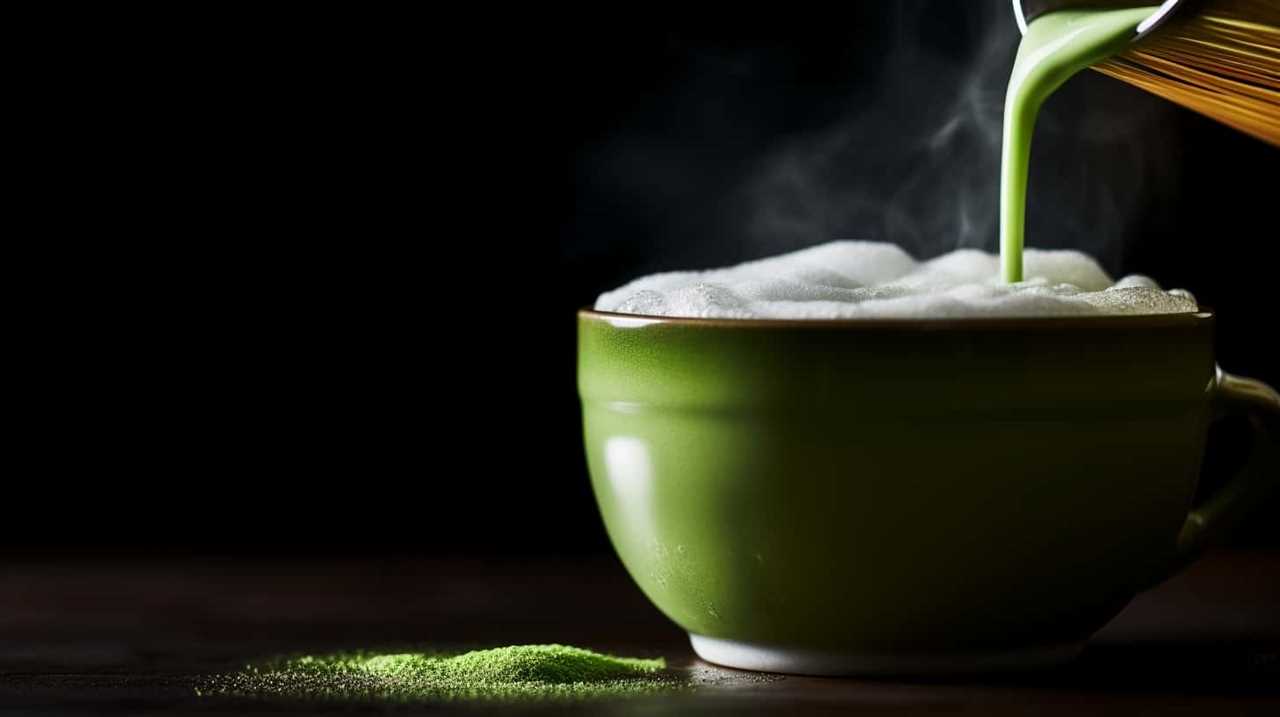
Using high-quality matcha powder ensures that we’re getting the full range of health benefits that matcha has to offer. Matcha is rich in antioxidants called catechins, which have been shown to have a variety of health benefits, including reducing the risk of heart disease and promoting weight loss. However, the quality of matcha can affect the levels of these beneficial compounds.
In addition to the health benefits, quality matcha powder also provides a more vibrant and complex flavor profile. Lower quality matcha powders can have a bitter or astringent taste, while high-quality matcha is smooth, slightly sweet, and has a rich umami flavor.
How Much Matcha Powder for Hot Matcha Tea
To make a perfect cup of hot matcha tea, we need to determine the appropriate amount of matcha powder to use. Adjusting matcha powder ratios is crucial in achieving the desired flavor and consistency. Here are some tips to help you find the right balance:
- Start with a teaspoon: For a standard 8-ounce cup of hot matcha tea, begin by using one teaspoon of matcha powder. This is a good starting point to gauge the strength and taste.
- Gradually increase or decrease: If the tea is too weak, add a little more matcha powder. On the other hand, if it’s too strong or bitter, reduce the amount of matcha powder used. Experiment and adjust until you find your preferred taste.
- Consider the quality: The quality of the matcha powder also affects the flavor. Higher-grade matcha powders tend to be more flavorful and vibrant. Finding the right matcha powder brand that suits your taste preferences is essential.
- Personal preference: It’s important to note that the perfect amount of matcha powder can vary based on personal preference. Some may prefer a stronger, more robust flavor, while others may enjoy a milder taste.
- Don’t forget to whisk: Regardless of the amount of matcha powder used, make sure to whisk it thoroughly to ensure a smooth, frothy texture.
How Much Matcha Powder for Iced Matcha Latte
For our iced matcha latte, we’ll need to determine the appropriate amount of matcha powder to use. The amount of matcha powder you use will depend on your personal preference and desired flavor intensity. It’s important to note that matcha powder can vary in quality and strength, so you may need to adjust the amount accordingly.

To start, you can follow a general guideline of using 1-2 teaspoons of matcha powder for every 8 ounces of liquid. However, feel free to experiment and adjust the amount based on your taste preferences. If you prefer a stronger matcha flavor, you can add more powder, and if you prefer a milder flavor, you can use less.
Keep in mind that different matcha recipes may require different amounts of powder. For example, if you’re making a blended iced matcha latte, you might want to use a slightly higher amount of matcha powder to ensure the flavor comes through when mixed with other ingredients.
In the next section, we’ll discuss how much matcha powder is typically used for a matcha smoothie.
How Much Matcha Powder for Matcha Smoothie
When making a matcha smoothie, it’s important to use the optimal amount of matcha powder to achieve the desired flavor and balance.
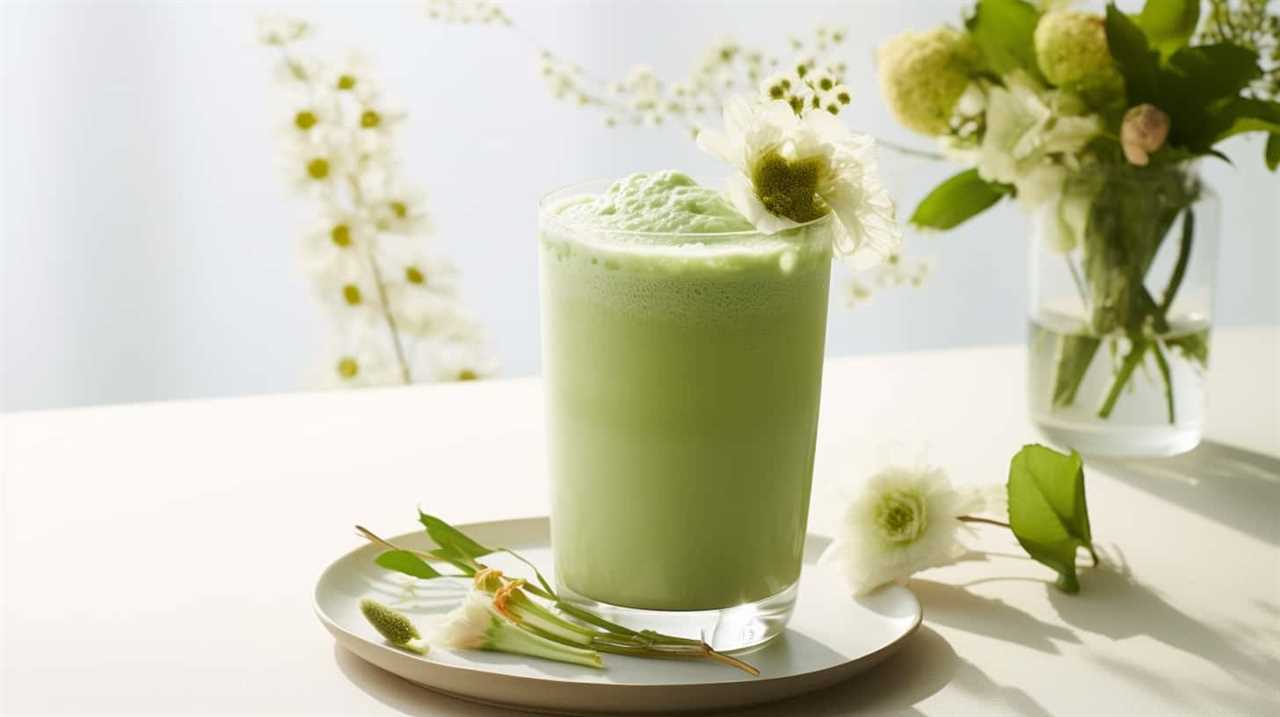
The amount of matcha powder can vary depending on personal preference and the other ingredients in the smoothie.
It’s recommended to start with a smaller amount and adjust as needed to find the perfect balance of matcha flavor in your smoothie.
Optimal Matcha Powder Amount
Since matcha smoothies require a specific amount of matcha powder for optimal taste and texture, we recommend using approximately 1 teaspoon for every 8 ounces of liquid. This ensures that you get the right balance of matcha flavor without overpowering the other ingredients.
Here are some reasons why the optimal matcha powder ratio is important for your smoothie:

- Enhanced flavor: Using the right amount of matcha powder allows you to enjoy the distinct, earthy taste that matcha brings to your smoothie.
- Smooth texture: The optimal matcha powder ratio helps create a smooth and creamy texture, ensuring that your smoothie is enjoyable to drink.
- Health benefits: Matcha powder is rich in antioxidants and can provide various health benefits, including boosting metabolism and improving focus.
- Balanced sweetness: Using the correct amount of matcha powder helps maintain a well-balanced sweetness in your smoothie, especially when adding other sweet ingredients.
- Consistency: Following the optimal matcha powder ratio ensures consistency in your smoothie’s taste and texture.
Adjusting Matcha Powder Quantity
To adjust the matcha powder quantity for matcha baked goods, it’s important to consider the recipe and the desired level of matcha flavor. The amount of matcha powder used can vary depending on personal preference and the intensity of flavor desired in the final product. Start by following the recipe’s recommended amount of matcha powder and taste the batter or dough to determine if it needs more matcha flavor. If a stronger matcha taste is desired, gradually add more matcha powder in small increments until the desired flavor is achieved. It’s important to keep in mind that too much matcha powder can overpower the other flavors in the baked goods and make them bitter. Finding the right balance of matcha powder is key to creating delicious matcha baked goods. Experimenting with different quantities of matcha powder allows you to customize the flavor and create treats that suit your taste preferences.
How Much Matcha Powder for Matcha Baked Goods
For our matcha baked goods, we typically use about 2 tablespoons of matcha powder. This amount provides a balanced and vibrant matcha flavor that pairs well with the sweetness of the baked goods.
However, it’s important to note that the amount of matcha powder can be adjusted based on personal preference and the specific recipe. Here are some tips for achieving the perfect matcha flavor in your baked goods:
- Start with the recommended amount: Begin with the suggested amount of matcha powder in the recipe and adjust from there. This will give you a baseline to work with.
- Taste as you go: Matcha powder can vary in intensity, so taste the batter or dough as you add the matcha powder. This will help you determine if you need to add more or if the flavor is just right.
- Consider the recipe: Some recipes, like cookies or muffins, may require a stronger matcha flavor, while others, like cakes or cupcakes, may benefit from a more subtle taste. Adjust the amount of matcha powder accordingly.
- Quality matters: High-quality matcha powder will have a more pronounced and authentic flavor. Invest in good quality matcha powder to achieve the best results.
- Experiment: Don’t be afraid to experiment with different amounts of matcha powder to find the perfect balance for your taste buds. Keep in mind that a little goes a long way, so start with small adjustments.
How Much Matcha Powder for Matcha Ice Cream
We typically incorporate about 1 tablespoon of matcha powder when making matcha ice cream. However, the amount of matcha powder you use can vary depending on personal preference and the flavor profile you are aiming for. Experimenting with different amounts of matcha powder can help you achieve the perfect balance of flavor in your ice cream.
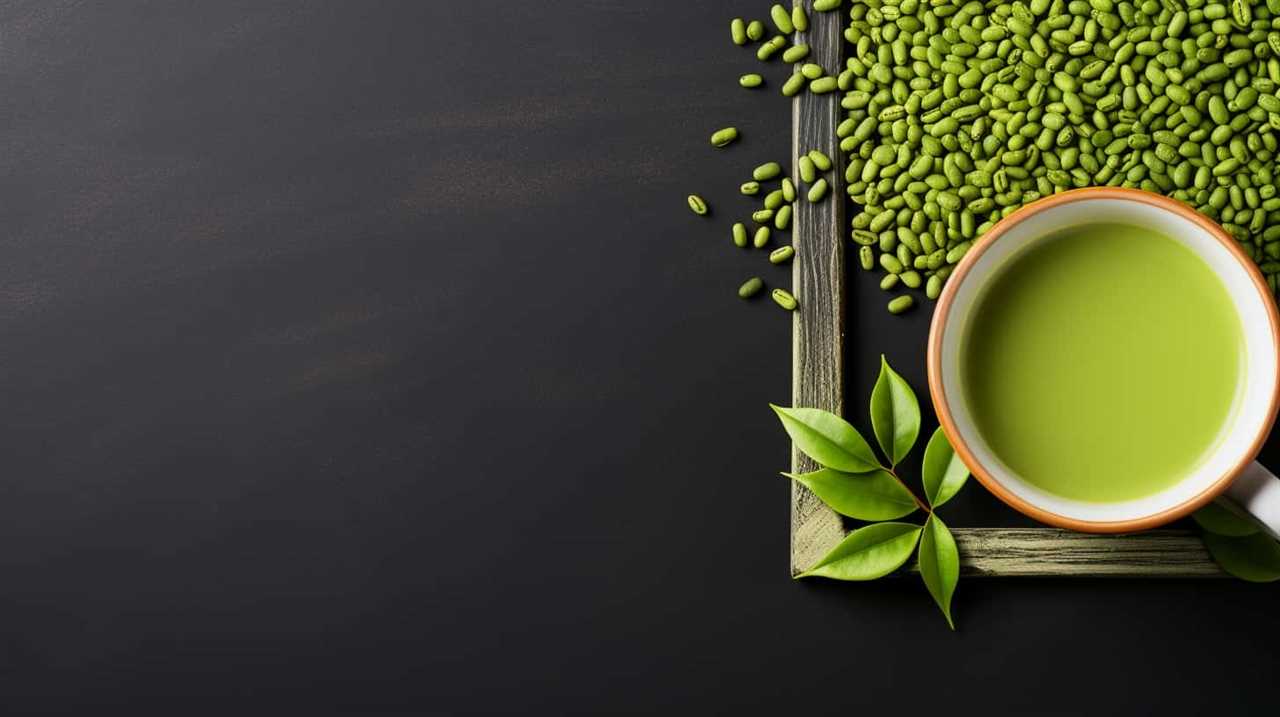
To give you an idea of how matcha powder can be adjusted for different flavors, here is a table showcasing some possible variations:
| Matcha Powder Amount | Flavor Intensity |
|---|---|
| 1 tablespoon | Balanced |
| 1.5 tablespoons | Bold |
| 2 tablespoons | Strong |
| 0.5 tablespoon | Subtle |
| 0.25 tablespoon | Delicate |
By adjusting the amount of matcha powder, you can create ice cream with varying levels of matcha flavor. Whether you prefer a subtle hint of matcha or a bolder taste, experimenting with matcha powder amounts allows you to customize your ice cream to your liking.
Now that we have discussed how much matcha powder to use for matcha ice cream, let’s move on to some tips for perfectly measuring matcha powder.
Tips for Perfectly Measuring Matcha Powder
When measuring matcha powder, it’s important to be precise and accurate in order to achieve the desired flavor in your matcha ice cream. Here are some tips to help you measure matcha powder perfectly for your matcha desserts:

- Use a fine mesh sieve: When measuring matcha powder, sift it through a fine mesh sieve to remove any lumps and ensure a smooth texture.
- Adjust for different recipes: Different recipes may require different amounts of matcha powder. Adjust the quantity based on the recipe to achieve the desired taste and color.
- Level off the measuring spoon: To accurately measure matcha powder, use a measuring spoon and level it off with a straight edge to remove any excess powder.
- Be mindful of the grade of matcha: The grade of matcha can affect its potency and flavor. Adjust the quantity accordingly, depending on whether you’re using ceremonial grade or culinary grade matcha powder.
- Experiment and taste: To find your perfect matcha flavor, don’t be afraid to experiment. Start with the recommended amount and adjust to your taste preferences.
By following these tips, you can ensure that you measure matcha powder accurately and achieve the perfect flavor in your matcha desserts.
Enjoy serving your delicious creations to others!
Frequently Asked Questions
Can Matcha Powder Be Used in Savory Recipes?
Yes, matcha powder can be used in savory recipes. Incorporating matcha into dishes adds a unique flavor profile and brings out the health benefits of matcha in savory dishes.
How Should Matcha Powder Be Stored to Maintain Its Freshness?
To preserve matcha powder freshness, store it in an airtight container in a cool, dark place. Avoid exposure to heat, light, and moisture. This will ensure that our matcha remains vibrant and flavorful for an extended period.
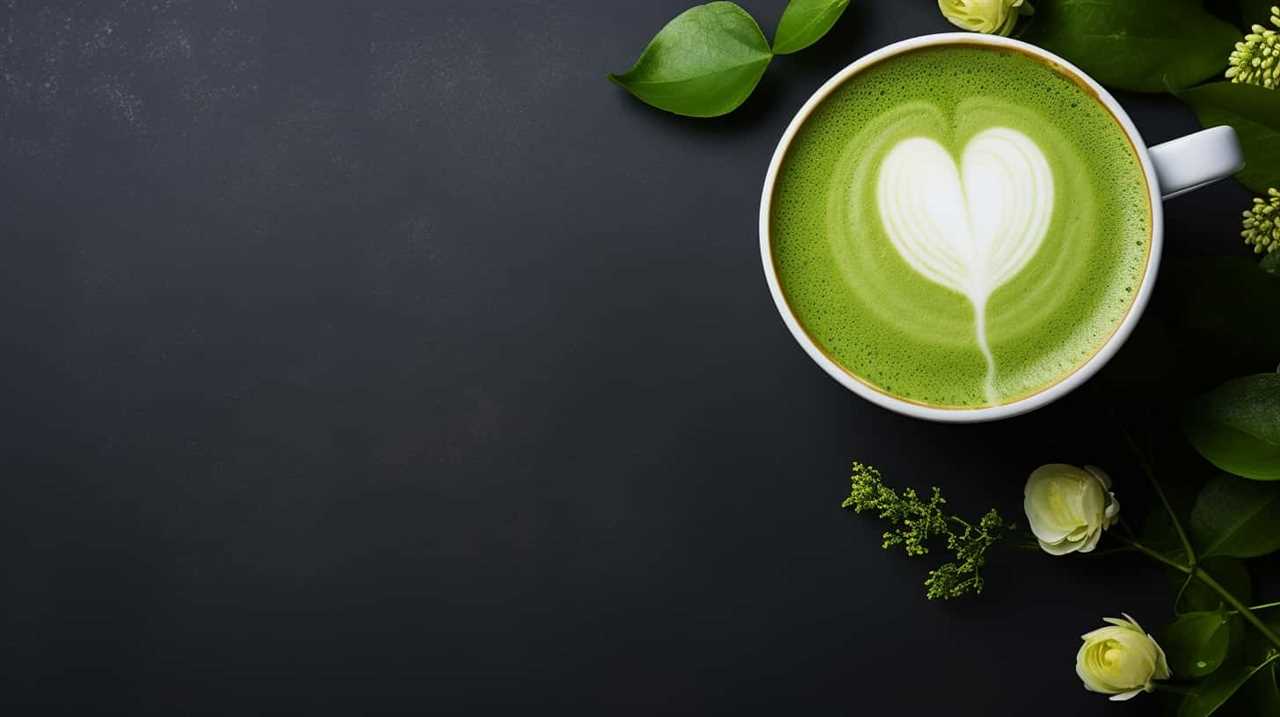
Is It Necessary to Sift Matcha Powder Before Using It?
Sifting matcha powder before using it is beneficial. It helps break up clumps, ensuring a smoother texture and more even distribution of flavor. Plus, it aerates the powder, resulting in a frothier and more vibrant cup of matcha.
Can Matcha Powder Be Used as a Substitute for Regular Green Tea in Recipes?
Matcha powder can be used as a substitute for regular green tea in recipes. It adds a vibrant green color and a unique flavor to dishes. We love using matcha powder as a natural food coloring and in smoothies and shakes.
What Are Some Alternative Uses for Matcha Powder Besides Beverages and Baked Goods?
We’ve discovered some great alternative uses for matcha powder! Get creative with matcha-infused smoothie bowls, energy balls, and even matcha-flavored ice cream. The possibilities are endless with this vibrant ingredient.
Conclusion
In the world of matcha, precision is key when it comes to measuring the perfect amount of powder for your favorite recipes.

Whether you’re making a matcha smoothie, baked goods, or ice cream, it’s important to find the right balance to achieve the desired flavor and consistency.
Remember, a pinch of matcha can make all the difference in creating a truly captivating culinary experience.
So, go ahead and embrace the art of measuring matcha powder, and let your taste buds dance with delight.
Justin is a seasoned author, coffee and tea enthusiast, and an essential member of the Cappuccino Oracle team. With a keen appreciation for the complexities of coffee, coffee alternatives, and tea, Justin has dedicated his professional career to exploring these realms and sharing his insights with readers worldwide.
Justin’s immersion in the world of coffee, coffee alternatives, and tea began at a young age, kindling a passion that extended beyond mere consumption. This love for these beverages led him to combine his talent for writing with his devotion to coffee and tea, bringing him to Cappuccino Oracle as a dedicated author.
Matcha
Unveiling The Mysteries Of Matcha: Insights On Its Origins, Production, And Quality

Have you ever been curious about the mysteries behind the rich and natural flavors of matcha? If so, get ready to join me on an adventure as we uncover the secrets of matcha, delving into its origins, production, and quality.
As a lover of all things tea, I have delved deep into the world of matcha, immersing myself in its rich history and intricate production process. From the shade-grown tea leaves to the meticulous grinding technique, every step is a labor of love that culminates in the velvety smooth powder we know as matcha.
Join me as we unravel the secrets behind this ancient Japanese tradition and discover why quality is key when indulging in this verdant elixir. We’ll explore the nuances of flavor, the importance of sourcing, and even delve into the fascinating world of other tea varieties.
So grab a cup, sit back, and let’s dive into the captivating world of matcha.
Key Takeaways
- Matcha tea is made from powdered green tea leaves and has a long and labor-intensive production process.
- Premium matcha is made from the first harvest in early spring, using the top 3 sprouts of the tea plant and ground tencha leaves.
- Cheaper matchas may skip some steps in the production process and are more suitable for matcha lattes.
- High-quality matcha is recommended for sparing consumption, as it has a smoother flavor and more health benefits compared to cheaper matchas.
What is matcha?
I’ve learned that matcha is a powdered green tea made from special tea leaves that are shaded before harvest, and it has a long and labor-intensive production process.
There are different types of matcha available, but the premium matcha is made from the first harvest in early spring, using only the top 3 sprouts of the tea plant. The leaves are then steamed, dried, and have their stems removed before being ground into a fine powder using a specialized mill made of granite.
It’s important to note that high-quality matcha is recommended for sparing consumption, as it has a complex production process that results in a smooth flavor. Matcha also offers various health benefits, such as being rich in antioxidants, boosting metabolism, and improving mental alertness.
Production process
The matcha production process involves shading the tea leaves before harvest and selecting the top three sprouts of the tea plant for premium matcha. Shading is a technique used to enhance the flavor and quality of the tea leaves. By covering the tea plants with shade, the leaves produce more chlorophyll and amino acids, resulting in a vibrant green color and a rich, umami taste.
After the shading period, only the top three sprouts of the tea plant are carefully handpicked for premium matcha. These selected leaves, known as tencha leaves, are then steamed, dried, and have their stems removed.
Finally, the tencha leaves are ground into a fine powder using a specialized granite mill. This process results in the smooth and concentrated matcha powder that we enjoy.
Quality and consumption
Let me tell you, indulging in high-quality matcha is like sipping a vibrant green elixir that awakens your taste buds and nourishes your body with its rich flavor and numerous health benefits. Matcha’s health benefits are truly remarkable. Packed with antioxidants, vitamins, and minerals, matcha is known to boost metabolism, enhance focus and concentration, and strengthen the immune system.
But not all matcha is created equal. Different grades of matcha exist, ranging from ceremonial grade to culinary grade. Ceremonial grade matcha is made from the highest quality tencha leaves and has a smooth, vibrant green color and a delicate, umami flavor. It is best enjoyed on its own, whisked with hot water.
On the other hand, culinary grade matcha is more affordable and is suitable for making matcha lattes, smoothies, and baked goods. Although it may have a slightly bitter taste and a duller color, it still provides health benefits.
So, whether you choose to indulge in high-quality ceremonial grade matcha or opt for the more affordable culinary grade, incorporating matcha into your routine is a delicious way to reap its health benefits.
Frequently Asked Questions
What are some popular ways to enjoy matcha besides drinking it as tea?
Besides drinking matcha as tea, some popular ways to enjoy it include indulging in matcha desserts like matcha ice cream, matcha cake, and matcha cookies. Additionally, matcha smoothies are a refreshing and healthy option.
Are there any specific health benefits associated with consuming matcha?
I’m no expert, but matcha is said to have potential health benefits. Some claim it can aid in weight loss due to its high antioxidant content and metabolism-boosting properties. However, more research is needed to confirm these claims.
How does the quality of matcha affect its flavor and overall experience?
The quality of matcha directly affects its flavor and overall experience. Higher quality matcha, made from carefully selected leaves and processed with precision, offers a smoother and more vibrant flavor, while lower quality matcha may have a less appealing taste and color.
Can matcha be used in cooking or baking?
"Where there’s matcha, there’s a way! Matcha can be used in a variety of cooking and baking recipes, adding a vibrant green color and a unique earthy flavor to dishes like matcha desserts."
Are there any specific tips or techniques for properly preparing matcha tea at home?
To properly prepare matcha tea at home, start by sifting the matcha powder to remove any clumps. Then, choose water at around 175°F to 180°F for the best flavor. Gradually add water to the matcha and whisk in a "W" or "M" motion until frothy. Enjoy!
Conclusion
In conclusion, matcha tea is not just a beverage, but a rich and fascinating tradition that has evolved over centuries.
From its origins in Japan to its intricate production process, matcha is a labor of love.
The quality of matcha is crucial, as the steps taken in its production directly impact its flavor and aroma.
Whether you’re a matcha connoisseur or a beginner, there is a matcha tea out there for you.
So, why not indulge in a cup of this vibrant green elixir and experience the magic of matcha for yourself? It’s a journey worth embarking on!
Arf, an author and an innovative enthusiast of coffee, coffee alternatives, and tea, plays a crucial role as a contributor to the esteemed Cappuccino Oracle platform. Renowned for his curiosity and passion for these captivating beverages, Arf has carved out a unique space for himself in the world of exploration and writing. He realized that coffee, coffee alternatives, and tea are not mere drinks to keep one awake, but universes of flavors and stories waiting to be explored.
Arf’s articles for Cappuccino Oracle blend meticulous research with personal experiences, providing readers with an in-depth understanding of various types of coffee, coffee alternatives, and tea, along with their unique characteristics, cultures, and histories. His honest reviews and engaging narratives guide readers on their own journeys, helping them discover their preferences and find their perfect brew.
Matcha
Unveiling The Truth Behind Starbucks’ Matcha: A Disappointing Blend

Being a lover of tea, I was eager to sample Starbucks’ matcha beverages, anticipating a flavorful and genuine taste. However, to my dismay, I found that it was a subpar mixture of inexpensive green tea powder and an excessive amount of sugar. This was a stark contrast to the customary matcha experience that I had grown accustomed to.
The use of low-quality matcha by Starbucks is driven by the need for mass production and a consistent taste across all locations. But in this pursuit, they have sacrificed the true essence of matcha. Authentic matcha production involves meticulous steps to ensure a high-quality and flavorful product, steps that Starbucks seems to skip.
The result is a matcha latte packed with 32 grams of sugar, equivalent to a can of soda, and a whopping 240 calories. It’s time to unveil the truth behind Starbucks’ matcha and explore better options for a truly satisfying tea experience.
Key Takeaways
- Starbucks uses a cheap green tea powder for their matcha drinks, which may not even be considered matcha.
- The cheap matcha powder is mixed with a lot of sugar, negating the health benefits and undermining the quality of the tea.
- Starbucks’ matcha latte contains a high amount of sugar, similar to a can of soda, and has a significant number of calories.
- To have a better matcha experience, it is recommended to explore premium, first harvest matcha made by talented farmers in Japan and to try different matcha options to find preferred taste.
What is Starbucks Matcha?
Starbucks Matcha is a cheap green tea powder mixed with a high amount of sugar, which not only undermines the health benefits of matcha but also fails to deliver the natural, great-tasting flavor of authentic matcha tea.
The ingredients used in Starbucks matcha include low-quality green tea powder that is likely produced on a large scale. Unlike traditional matcha production methods, Starbucks skips certain steps to save time and money. These steps, such as shading the tea plants to reduce bitterness and selecting the top leaves for their flavor and nutrients, are crucial in creating high-quality matcha.
Instead, Starbucks opts for a blend of cheap green tea powder mixed with sugar, resulting in a dull and bitter flavor. This disappointing blend of ingredients does not live up to the standards of true matcha tea.
Quality vs. Cheap Matcha
Indulging in high-quality matcha is like savoring a delicate melody that dances on your taste buds, while settling for cheap matcha is akin to a discordant symphony that leaves a bitter aftertaste. When it comes to matcha, quality matters. Traditional matcha production is an art that requires time, patience, and attention to detail. The importance of shading the tea plants, selecting the top leaves, and using a stone mill to grind the leaves into a fine powder cannot be overstated. These steps not only enhance the flavor but also preserve the health benefits of matcha. High-quality matcha is rich in antioxidants, boosts metabolism, and promotes a sense of calm. On the other hand, cheap matcha often lacks these qualities as it skips crucial steps and is mixed with sugar and other additives. Don’t settle for a subpar matcha experience; choose high-quality matcha for its exceptional taste and health benefits.
| Traditional Matcha Production |
|---|
| Shading the tea plants |
| Selecting the top leaves |
| Grinding with a stone mill |
The importance of traditional matcha production cannot be overstated. These steps not only enhance the flavor but also preserve the health benefits of matcha. High-quality matcha is rich in antioxidants, boosts metabolism, and promotes a sense of calm. On the other hand, cheap matcha often lacks these qualities as it skips crucial steps and is mixed with sugar and other additives. Don’t settle for a subpar matcha experience; choose high-quality matcha for its exceptional taste and health benefits.
Recommendations for Better Matcha
Exploring different matcha options can lead to a better matcha experience. When it comes to matcha, not all options are created equal. While Starbucks may offer a convenient matcha latte, there are alternative options that provide a more authentic and higher quality experience.
Premium matcha, specifically first harvest matcha, is made by talented farmers in Japan and can be enjoyed plain, without the need for excessive sugar or additives. By choosing premium matcha, you can reap the full benefits that matcha has to offer, such as its high antioxidant content and potential health benefits.
Additionally, exploring different types of matcha, such as Japanese black tea, can expand your taste palate and introduce you to new and exciting flavors. So, why settle for a disappointing blend when there are better matcha options out there waiting to be explored?
Frequently Asked Questions
How is Starbucks matcha different from traditional matcha?
Starbucks matcha differs from traditional matcha in terms of quality and taste. One interesting statistic is that Starbucks’ matcha latte contains 32 grams of sugar, similar to a can of soda, which undermines the health benefits of matcha.
What are the health benefits of matcha and how do they differ between Starbucks matcha and premium matcha?
The health benefits of matcha include high levels of antioxidants, increased energy, and improved focus. However, Starbucks matcha quality is compromised due to the use of cheap powder mixed with sugar, negating these benefits.
Can you customize the sweetness level of Starbucks matcha drinks?
Yes, you can customize the sweetness level of Starbucks matcha drinks. They offer popular matcha drink variations like matcha latte and matcha frappuccino, allowing customers to choose the amount of sweetener they prefer.
Are there any alternative options for matcha drinks at Starbucks?
Yes, there are alternative options for matcha drinks at Starbucks. However, it’s important to note that the taste may not be comparable to traditional matcha. Exploring different matcha options and Japanese black tea can provide a better experience.
What are the steps involved in producing high-quality matcha and how does Starbucks’ matcha production differ?
Starbucks’ matcha production process differs from traditional matcha production in Japan. High-quality matcha involves shading the tea plants, selecting the top leaves, steaming, drying, and grinding them. However, Starbucks skips these steps, resulting in a lower quality and less authentic matcha experience.
Conclusion
In conclusion, after delving into the truth behind Starbucks’ matcha, it’s clear that their blend falls short of expectations. The use of cheap green tea powder mixed with excessive sugar dilutes any potential health benefits and fails to deliver an authentic matcha experience.
To truly enjoy the rich and flavorful taste of matcha, it’s recommended to explore premium, first harvest options crafted by skilled Japanese farmers. Don’t settle for subpar matcha; treat yourself to a tea experience that’ll leave your taste buds dancing with delight.
Arf, an author and an innovative enthusiast of coffee, coffee alternatives, and tea, plays a crucial role as a contributor to the esteemed Cappuccino Oracle platform. Renowned for his curiosity and passion for these captivating beverages, Arf has carved out a unique space for himself in the world of exploration and writing. He realized that coffee, coffee alternatives, and tea are not mere drinks to keep one awake, but universes of flavors and stories waiting to be explored.
Arf’s articles for Cappuccino Oracle blend meticulous research with personal experiences, providing readers with an in-depth understanding of various types of coffee, coffee alternatives, and tea, along with their unique characteristics, cultures, and histories. His honest reviews and engaging narratives guide readers on their own journeys, helping them discover their preferences and find their perfect brew.
Matcha
The Ultimate Guide To Using Chashaku: Your Matcha Essential

Being a lover of matcha, I am aware that the crucial factor in achieving the perfect matcha bowl is the equipment we utilize. When it comes to preparing matcha, there is one tool that is particularly essential: the chashaku.
This bamboo spoon, with its elegant design and precise measurements, is the secret weapon of matcha lovers worldwide. In this ultimate guide, I will take you on a journey through the history and evolution of the chashaku, and show you how to use it like a pro.
From its origins as a metal or ivory scoop to its modern-day incarnation in bamboo, the chashaku has come a long way. With its 48° bend and 18mm length, it effortlessly scoops the perfect amount of matcha from its container.
So grab your chashaku and get ready to elevate your matcha game to new heights. Let’s dive in and discover the wonders of this matcha essential.
Key Takeaways
- Chashaku is a bamboo spoon used to scoop matcha powder in the Japanese tea ceremony and by matcha lovers worldwide.
- Chashaku is one of the three important tea utensils used in the tea ceremony and is about 18mm in length with a 48° bend at the end for scooping.
- Chashaku is made of bamboo to avoid negative reactions with matcha powder and is a great measurement tool for matcha powder.
- Two scoops of chashaku is the standard amount for a bowl of matcha tea, and it is easy to maneuver in matcha tins or natsume due to its small size.
What is Chashaku?
Chashaku is a bamboo spoon used to scoop matcha powder, and it’s one of the three important tea utensils used in the Japanese tea ceremony.
Made from a single piece of bamboo, this elegant tool has a long history dating back to the Muromachi period in Japan. Originally crafted from metal or ivory, chashaku evolved to be made of bamboo due to its natural properties and to avoid any negative reactions with matcha powder.
The design of chashaku is both functional and beautiful, with a length of about 18mm and a 48° bend at the end for easy scooping. There are different styles of chashaku scoops, each with its own unique shape and characteristics. The back of the chashaku has a rough texture, while the face is smooth and sleek.
Whether you’re a matcha lover or a tea ceremony enthusiast, using a chashaku adds a touch of authenticity and tradition to your matcha preparation.
History and Evolution
During the Muromachi period in Japan, the chashaku spoon evolved from being made of metal or ivory to its current bamboo form, which is about 18mm in length and has a 48° bend at the end for easier scooping. The history and evolution of the chashaku is a testament to its significance in Japanese tea ceremonies and its cultural importance in matcha preparation.
| The significance of chashaku in Japanese tea ceremonies | The cultural importance of chashaku in matcha preparation |
|---|---|
| Chashaku is one of the three important tea utensils used in the tea ceremony. | Chashaku is a great measurement tool for matcha powder. |
| Chashaku originated in Japan during the Muromachi period. | Chashaku’s small size allows for easy maneuvering in matcha tins or natsume. |
| Originally made of metal or ivory, chashaku evolved to be made of bamboo. | Chashaku is made from a single piece of bamboo and shaped with a bend for the scoop. |
| Chashaku is made of bamboo to avoid negative reactions with matcha powder. | The back of chashaku has a rough texture, while the face is smooth and sleek. |
The chashaku’s role in Japanese tea ceremonies cannot be understated. It is one of the three essential utensils used in the tea ceremony, alongside the chawan (tea bowl) and chasen (tea whisk). The chashaku’s small size and precise measurement make it the perfect tool for scooping matcha powder. Its evolution from metal or ivory to bamboo shows the cultural importance placed on this utensil. The chashaku’s design, with its gentle bend and smooth face, allows for easy and graceful scooping of matcha. Using the chashaku is not only practical but also a way to honor the centuries-old tradition of matcha preparation.
How to Use Chashaku
To use the chashaku, I simply hold it like a pencil and dip the scoop into the matcha container. Then, I carefully lift the chashaku scoop out and place it over the matcha bowl to dump the powder.
It’s a simple and elegant technique that ensures the perfect amount of matcha every time.
But did you know that there are alternative ways to use the chashaku? Some matcha lovers prefer to use a teaspoon or a regular spoon to scoop their matcha powder. While these alternatives may work in a pinch, they don’t offer the same precision and authenticity as the chashaku.
The chashaku’s unique design and size make it the ideal tool for measuring matcha powder. Plus, using the chashaku adds a traditional touch to the matcha preparation process, enhancing the overall experience.
So why settle for anything less? Embrace the chashaku and elevate your matcha game to the next level.
Frequently Asked Questions
What are the different types of materials used to make chashaku besides bamboo?
There’s something truly magical about the chashaku, the bamboo spoon that gracefully scoops matcha powder. While bamboo is the traditional material, chashaku can also be made from metal or ivory, although these alternatives are less common.
Can chashaku be used to scoop other powders besides matcha?
Yes, chashaku can be used to scoop other powders besides matcha. However, it is primarily designed for scooping matcha powder and is most commonly used in Japanese tea ceremonies. To properly clean and care for a chashaku, it is recommended to wipe it with a dry towel or tissue to avoid water damage. The chashaku is a versatile tool with different uses in the tea ceremony, making it an essential item for matcha lovers.
How long does a chashaku typically last before it needs to be replaced?
A chashaku typically lasts for a long time, but the lifespan can vary depending on the material. Bamboo chashaku is the most common and durable option, while metal or ivory may wear down over time. Proper care involves cleaning with a dry towel or tissue to avoid water damage.
Can chashaku be used with different types of matcha bowls or is it specific to a certain style?
Absolutely! Chashaku can be used with various types of matcha bowls, adapting to different styles. Its small size and unique design make it perfect for scooping matcha powder and adding a touch of elegance to your matcha preparation.
Are there any alternative utensils that can be used in place of chashaku for scooping matcha powder?
Yes, there are alternative utensils for scooping matcha powder, such as a teaspoon or a small spoon. However, using a chashaku has its benefits. Its unique design allows for precise measurements and easy maneuvering in matcha tins.
Conclusion
In conclusion, using chashaku isn’t just a practical way to measure and scoop matcha powder, but it’s also an essential tool for embracing the art and tradition of the Japanese tea ceremony.
While some may argue that using a regular spoon can achieve the same result, chashaku offers a unique experience that connects us to centuries of tea culture. Imagine holding the slender bamboo spoon, feeling the weight of tradition in your hand, and delicately scooping the vibrant green matcha powder.
It’s a sensory journey that brings us closer to the beauty and mindfulness of matcha preparation. So, embrace the chashaku, and let it elevate your matcha experience to new heights.
Arf, an author and an innovative enthusiast of coffee, coffee alternatives, and tea, plays a crucial role as a contributor to the esteemed Cappuccino Oracle platform. Renowned for his curiosity and passion for these captivating beverages, Arf has carved out a unique space for himself in the world of exploration and writing. He realized that coffee, coffee alternatives, and tea are not mere drinks to keep one awake, but universes of flavors and stories waiting to be explored.
Arf’s articles for Cappuccino Oracle blend meticulous research with personal experiences, providing readers with an in-depth understanding of various types of coffee, coffee alternatives, and tea, along with their unique characteristics, cultures, and histories. His honest reviews and engaging narratives guide readers on their own journeys, helping them discover their preferences and find their perfect brew.
-

 Americano4 weeks ago
Americano4 weeks agoHow to Make Americano With Moka Pot
-

 Americano2 weeks ago
Americano2 weeks agoHow to Make Korean Iced Americano
-

 Americano4 weeks ago
Americano4 weeks agoHow to Make Americano With Bialetti
-

 Americano4 weeks ago
Americano4 weeks agoHow to Make Dutch Bros Americano
-

 Americano1 week ago
Americano1 week agoHow to Make an Iced Americano With Nespresso
-

 Americano2 weeks ago
Americano2 weeks agoHow Many Shots of Espresso for 16 Oz Americano
-

 Americano4 weeks ago
Americano4 weeks agoHow to Make a Hazelnut Americano
-

 Turmeric Tea1 week ago
Turmeric Tea1 week agoTurmeric Saffron Tea

















